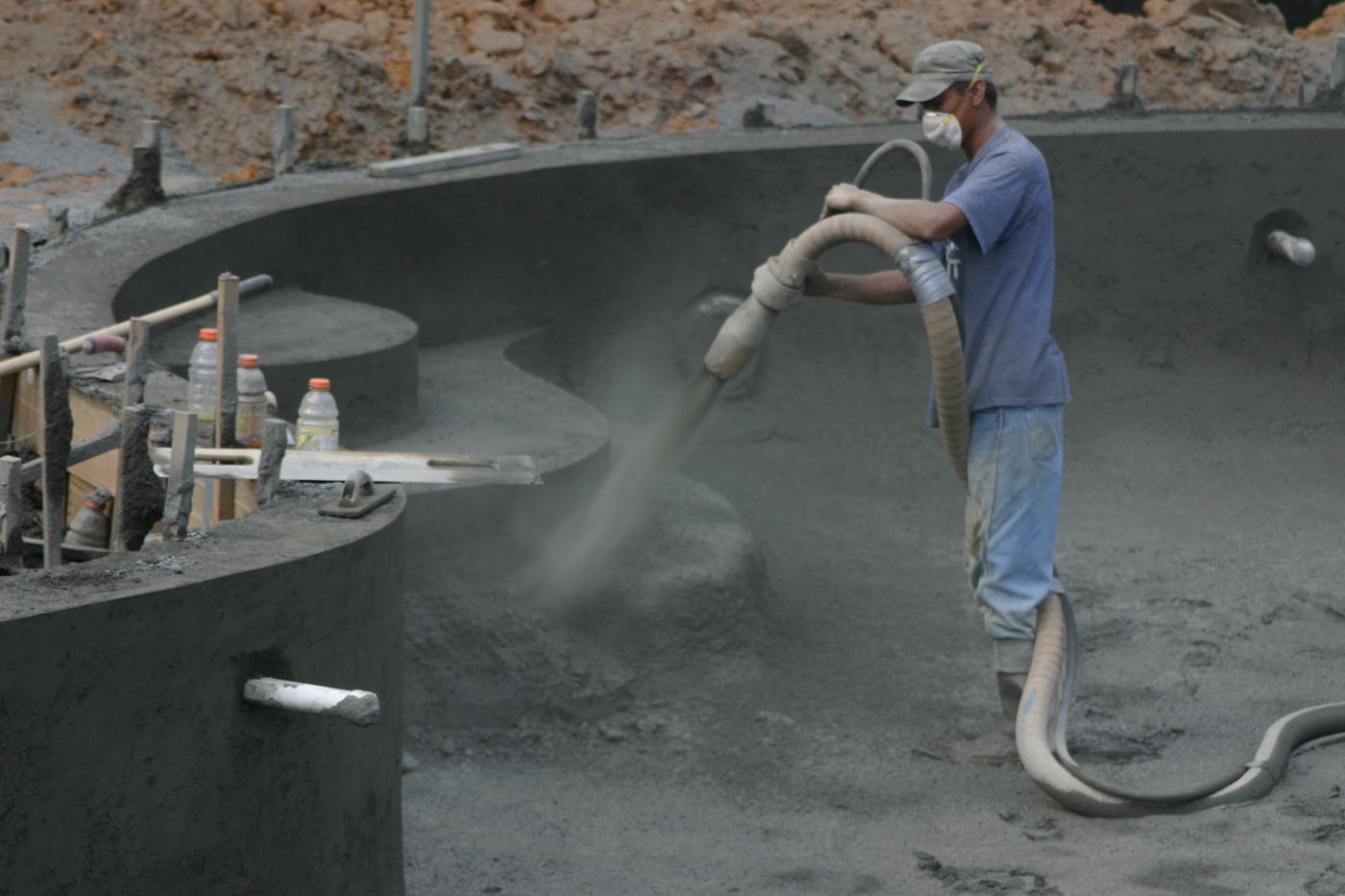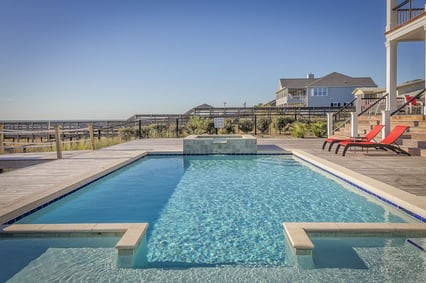
What is a Gunite Pool? How They’re Built, What They Cost, and What to Expect
Fiberglass vs Concrete vs Vinyl Liner | Installation & Construction | Pool Maintenance | Cost and Pricing | Concrete Pool Information
Thinking about getting a new swimming pool for your backyard? You probably know about the three types of inground pools: concrete, fiberglass, and vinyl liners.
If you’ve been leaning towards getting a concrete pool, you’ve probably heard the term “gunite” at least a few times. We’ve been in the pool business for a long time, so we can sometimes take our knowledge and terminology for granted -- but we know there can be a lot to learn about inground swimming pools before you can confidently make the best choice for your backyard oasis.
Want to know more about gunite pools? You’ve come to the right place.
Let’s start with the obvious and most straightforward question: what is gunite?
What is gunite? (a brief history of concrete)
Gunite is concrete.
To be more specific, the term “gunite” actually refers to the process through which concrete is transformed from a big old glob of thick goo into a beautiful and functional swimming pool.
Concrete isn’t always easy to work with. It’s a dense industrial material that dries quickly and retains its solid shape superbly for a very long time.
Historically, most concrete construction used removable forms or molds to create shaped concrete, or workers would use concrete as a form of mortar to bind other materials together or to strengthen their exteriors.
Concrete has been used for thousands of years, and many concrete structures are still standing today. Roman architecture is the best-known example of durable concrete structures from the ancient world, but we now know concrete-like mixtures have been used as a building material since roughly 6,500 BC.
How does the gunite process work?
The gunite process was invented in 1907 by a taxidermist named Carl Akely -- who apparently dabbled a bit in industrial construction when he wasn’t stuffing animal carcasses -- to fix the Field Columbian Museum in Chicago.

Gunite uses pressurized air to push dry concrete mix through a tube or hose. This dry mixture combines with water in a nozzle at the end of the hose, which shoots the now-mixed concrete onto whatever surfaces it’s pointed at.
Gunite results in a relatively thin layer of wet concrete, which is blasted at high speed and pressure onto any surface to which it can adhere.
The combination of high pressure and absolutely last-second mixture of the dry concrete mix with water needs to be conducted just right, or the final mixture may be too dry or become too wet and not adhere properly to its intended final surface. This is why gunite construction relies on the expertise and talent of the nozzleman controlling the flow of dry mix and water at the nozzle.
What is gunite made of?
Gunite, as mentioned earlier, is a process for applying concrete to various surfaces.
Concrete hasn’t changed much since Roman times. It’s typically a combination of cement, sand, and some type of aggregate -- little bits of hard material that are slightly larger than sand, such as crushed stone or small pieces of gravel -- mixed with water.
There are a few different types of cement, but it’s usually made of lime or silicate powder. China produces most of the world’s cement, and cement is actually the most widely-used manmade material in the world, and is second only to water as the most widely-used substance in the world.
In many ways, cement and water are the building blocks for our modern society. Concrete is just a somewhat more complex and resilient product that makes water and cement more effective than they might be on their own.
What is a gunite pool?
Gunite-built concrete pools have been around since the 1940s. They became popular backyard features after World War 2, as millions of returning soldiers moved their families to new suburbs and began seeking out more creature comforts for their properties.
Concrete pools have been around for centuries -- Roman baths were usually made of concrete, for example.
Gunite simply made it easier for local construction companies in the United States (and elsewhere) to build attractive and highly customizable pools in suburban backyards, without as much heavy equipment and time-consuming form construction (remember, forms create shapes or molds into which concrete can be poured until it dries) as might have been otherwise needed.
How are gunite pools made?
Like all other types of inground pools, a gunite pool begins with the dig or excavation. Heavy machinery will move into your backyard to dig a hole that’s as near to the depth, width, shape, and size of the pool design you want.
Once this hole is ready, workers begin installing plumbing for your pool while also reinforcing the walls and floor of the excavated hole with steel rebar, which forms a sturdy cage onto which the pool builder’s nozzleman can spray gunite.
Gunite has some critical advantages over the similarly-applied shotcrete (read more about the similarities and differences in our Gunite vs. Shotcrete article), one of which is its ability to be applied in stages, rather than requiring a one-and-done approach.
Most forms of concrete, including shotcrete, don’t bind well together if applied at different times, which can create structural cracks or flaws, and otherwise mess up the visual integrity of the desired concrete surface.
Gunite-applied concrete, however, is applied with so much pressure, and mixed with water at such a late stage in the process, that a good nozzleman can spray gunite several days apart and still create a durable, attractive concrete surface without risking structural flaws.
How long does gunite take to cure?
Once all the concrete has been sprayed down by the gunite process, the concrete must be left to cure for a period of time before the concrete pool can be safely filled with water.

Concrete applied by the gunite process needs to cure for roughly one month (28 days) for the particles and molecules in the concrete mixture to fully bond together and reach their maximum strength and durability.
While it is possible to lay down additional gunite-sprayed concrete while existing concrete surfaces are curing, it will extend the total cure time.
For this reason, most gunite pool builders will still try to complete the gunite application process quickly, so as to avoid an extended period of curing. Bad weather conditions can interfere with the curing process as well, and gunite pool surfaces may often develop small cracks regardless of the nozzleman’s skill.
What else is involved in constructing a gunite pool?
The visible surface of a cured gunite swimming pool is typically covered in plaster or tile, or some other “finished” material, to create a more consistently even surface texture and color.
Since this may not happen for at least a month after the final spray, your pool builder will typically install any coping around the edge of the pool, and will generally build your patio area while the gunite cures as well.
While waiting for your gunite pool to cure, your pool builder might also install any add-ons and accessories included in your project, such as fencing, retaining walls, landscaping, and water features that don’t need to originate inside the pool itself.
How long does it take to build a gunite swimming pool?
From start to finish, the gunite pool construction process will usually take between three to six months to complete -- and that’s just the active period in which something is actually happening in your backyard.
A combination of extraordinarily high demand and constrained supplies of raw materials have stretched builder backlogs out for months, if not well into next year.
It’s quite possible any gunite swimming pool you sign up for won’t be ready for use until the end of 2022’s swim season. This isn’t to say you’d be able to get other types of pools in the ground and ready for use much earlier. But if you must swim ASAP, a gunite pool might not be your best option.
What does a gunite pool cost?

Historically, gunite swimming pools have cost between $55,000 and $100,000 for a turnkey installation, with essential options included. However, we rarely see gunite installations that cost less than $100,000 in today’s COVID-era pool market.
Because gunite pools (and shotcrete pools, for that matter) can be customized to any size, shape, and depth, with just about any features imaginable, their costs can quite quickly shoot past the six-figure mark, even if you’re trying to install a smaller and less distinctive gunite pool design.
What to expect when maintaining a gunite pool
Gunite pools can also be costly to maintain over time. On average, we’ve seen gunite and shotcrete pools cost over $2,700 a year over a 10-year period.
This $27,000-plus maintenance cost for 10 years includes more chemicals and electricity usage than you’d need for similarly-sized fiberglass or vinyl liner pools.
It also includes expensive but unavoidable replastering and acid washing costs -- the surface of your concrete pool might look great on day one, but it won’t last forever, and you’ll have to effectively replace it all every 10-15 years.
Check out our infographic for more information on the maintenance costs for gunite pools, as well as for fiberglass and vinyl liner pools:

If you’re still working through your options before buying an inground swimming pool, try our quick Pool Type Quiz. It takes just a couple of minutes, and you’ll come away with much greater clarity on the type of pool that might best suit your backyard and unique needs. Just click the button below to start your quiz!
If you're shopping around for a fiberglass pool, feel free to take a look at our catalog of models, visit our extensive video library, try out our pool cost calculator, or request custom pricing using the button below.
Editor's note: This article was updated on September 12, 2023.
Editor's note (5/17/24):
This article was originally written by Alex Planes. Any opinions expressed are those of the author. Any prices referenced were based on information that was readily available at the time.
River Pools is a brand of inground fiberglass pools produced via the River Pools division of the manufacturing facility in Fortville, IN. While our expertise is in fiberglass pool manufacturing, we have a network of expertise relating to all things inground pools. Our own collective experience from over the years spans manufacturing, project design, installation, and pool service. We often tap into this knowledge base and share information freely with homeowners, just like you, who are considering having a swimming pool installed in your backyard.






